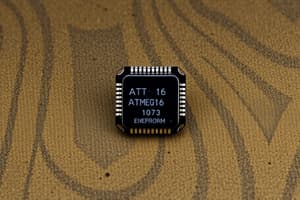Podcast
Questions and Answers
What is the main function of a Digital to Analog Converter (DAC)?
What is the main function of a Digital to Analog Converter (DAC)?
- To convert analog signals to digital signals
- To connect different types of sensors
- To enable the connection of various actuators
- To create an analog representation of digital signals (correct)
Which interface is typically faster and easier to use for transferring a byte of data at a time?
Which interface is typically faster and easier to use for transferring a byte of data at a time?
- Tri-state buffer
- Parallel interface (correct)
- GPIO
- Serial interface
What is the main component that controls the direction of data flow in a Digital Input Output (DIO) pin?
What is the main component that controls the direction of data flow in a Digital Input Output (DIO) pin?
- Digital-to-analog converter
- General-purpose I/O
- Analog-to-digital converter
- Tri-state buffer (correct)
In which communication mode can data move in two directions at the same time?
In which communication mode can data move in two directions at the same time?
Which type of interface is often used on GPIO pins of a microcontroller?
Which type of interface is often used on GPIO pins of a microcontroller?
Which type of interface can be used for long-distance communication?
Which type of interface can be used for long-distance communication?
What is the main purpose of an Analog-to-Digital Converter (ADC)?
What is the main purpose of an Analog-to-Digital Converter (ADC)?
Which interface allows data to move in two directions, but not at the same time?
Which interface allows data to move in two directions, but not at the same time?
What is the main function of an actuator?
What is the main function of an actuator?
What is the main purpose of a General-Purpose Input/Output (GPIO) pin?
What is the main purpose of a General-Purpose Input/Output (GPIO) pin?
Flashcards are hidden until you start studying
Study Notes
Memory Types
- EEPROM (Electrically Erasable Programmable ROM): programmed and erased by electrical signals
- Flash ROM: accessed in blocks of bytes, good for large storage, 10,000 to 100,000 erase cycles
- RAM (Random Access Memory): used for runtime because it is faster than ROM, loses data when power is off
- ROM (Read-Only Memory): used for code storage, retains data when power is off
Input/Output Peripherals
- Digital Input/Output (DIO)
- Analog-to-Digital Converter (ADC)
- Digital-to-Analog Converter (DAC)
- Timers and Pulse Width Modulators (PWM)
- Universal Asynchronous Receiver Transmitter (UART)
- Serial Peripheral Interface (SPI)
- Inter Integrated Circuit (I2C) Serial Communication Protocols
ES Architecture
- Von Neumann Architecture: processor, memory (RAM & ROM), address bus, data bus, control bus
- Harvard Architecture: separate buses for program memory (ROM) and data memory (RAM)
Sensors and Actuators
- Sensors: measure physical quantities, input/read from the physical world
- Examples: cameras, magnetometers, accelerometers, radar/lidar, gyroscopes, chemical, strain gauges, microphones, pressure sensors
- Actuators: modify physical quantities, output/write to the physical world
- Examples: motor controllers, LEDs, LCD and plasma displays, loudspeakers, switches, fluids, solenoids, valves
ADC/DAC
- ADC (Analog-to-Digital Converter): takes an analog signal and creates a digital representation
- DAC (Digital-to-Analog Converter): takes a digital signal and creates an analog representation
Instruction Set and Processor Operation
- Every processor has a unique instruction set and opcode
- Decoding step defines the operation and operands of an instruction
- Example instruction format: Op Code, Operand 1, Operand 2
Compilation and Execution
- A compiler is target-specific, cannot compile for a different processor
- Compiled code is specific to a processor, cannot be executed on a different processor
Sensors and Actuators: Interfaces
- Simple Digital I/O: GPIO, open collector circuits, can be used for input and output
- Parallel/Serial Interface: parallel is faster and easier, serial is cheaper and ideal for long distance
- DIO (Digital Input/Output): deals with digital signals, can be used for input or output modes
- Tri-State Buffer: controls the direction of data in a DIO pin
Studying That Suits You
Use AI to generate personalized quizzes and flashcards to suit your learning preferences.




